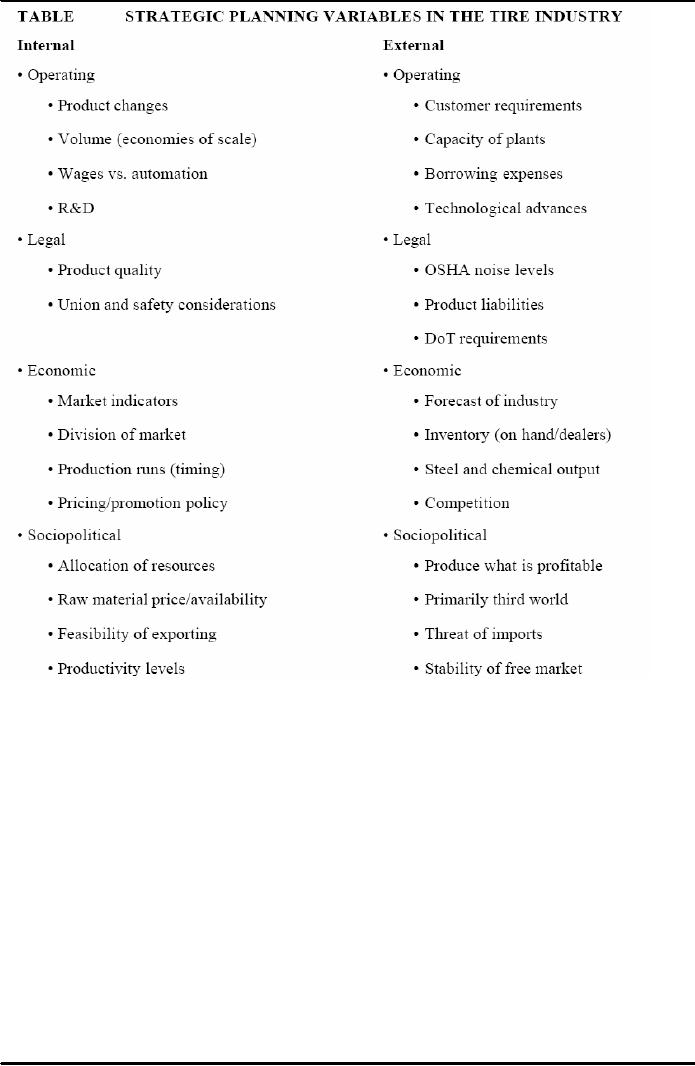 |

Project
Management MGMT627
VU
LESSON
19
PROJECT
PLANNING (CONTD.)
Broad
Contents
Identifying
Strategic Project Variables
19.1
Identifying
Strategic Project
Variables:
The
project manager must
continually monitor the external
environment in order to develop
a
well-structured
program that can stand up
under pressure (for
long-range or strategic projects).
These
environmental factors play an integral
part in planning. The
project manager must be
able
to
identify and evaluate these
strategic variables in terms of the
future posture of the
organization
with regard to constraints on existing
resources.
As
we know that in the project
environment, strategic project planning
is performed at the
horizontal
hierarchy level, with final
approval by upper-level management.
There are three
basic
guidelines for strategic project
planning:
�
It
is extremely important that
upper-level management maintain a
close involvement
with
project
teams, especially during the
planning phase.
�
Successful
strategic planning must define the
authority, responsibility, and roles of
the
strategic
planning personnel.
�
Strategic
project planning is a job
that should be performed by
managers, not for
them.
In
order to ensure the success of the
project, all members of the
horizontal team must be
aware
of
those strategic variables that
can influence the success or
failure of the project plan.
The
analysis
begins with the environment, subdivided
as internal, external, and competitive,
as
shown
below:
�
Internal
Environment
�
Management skills
�
Resources
�
Wage and salary levels
�
Government freeze on
jobs
�
Minority groups
�
Layoffs
�
Sales forecasts
�
External
Environment
�
Legal
�
Political
�
Social
�
Economic
�
Technological
�
Competitive Environment
�
Industry characteristics
�
Company requirements and goals
�
Competitive history
�
Present competitive
activity
�
Competitive planning
141

Project
Management MGMT627
VU
--
Return on investment
--
Market share
--
Size and variety of product
lines
�
Competitive
Resources
It
is important to note here
that once the environmental
variables are defined, the
planning
process
continues with the following:
�
Identification
of company strengths and
weaknesses
�
Understanding
personal values of top management
�
Identification
of opportunities
�
Definition
of product market
�
Identification
of competitive edge
�
Establishment
of goals, objectives, and
standards
�
Identification
of resource deployment
At
the program level, complete
identification of all strategic variables
is not easily
obtainable.
However,
internal, or operating, variables
are readily available to
program personnel by virtue
of
the structure of the organization. The
external variables are
normally tracked under the
perceptive
eyes of top management. This
presents a challenge for the
organization of the
system.
In most cases, those in the
horizontal hierarchy of a program
are more interested in the
current
operational plan than in
external factors and tend to become
isolated from the
environment
after the program begins, losing
insight into factors influencing the
rapidly
changing
external variables in the process. Proper
identification of these strategic
variables
requires
that communication channels be
established between top management and the
project
office.
It
is essential that the top-management support
must be available for
identification of strategic
planning
variables so that effective
decision making can occur at the
program level. The
participation
of top management in this regard
has not been easy to
implement. Many
top-level
officers
consider this process a relinquishment of
some of their powers and
choose to retain
strategic
variable identification for the
top levels of
management.
It
is important to note here
that the systems approach to management
does not attempt to
decrease
top management's role in strategic
decision-making. The maturity,
intellect, and
wisdom
of top management cannot be replaced.
Ultimately, decision-making will
always rest at
the
upper levels of management,
regardless of the organizational
structure.
Therefore,
identification and classification of the strategic
variables are necessary to
establish
relative
emphasis, priorities, and selectivity
among the alternatives, to anticipate
the
unexpected,
and to determine the restraints and limitations of the
program. Universal
classification
systems are nonexistent
because of the varied nature of
organizations and projects.
However,
variables can be roughly categorized as
internal and external, as shown in Table
19.1
below.
142

Project
Management MGMT627
VU
Table
19.1: Strategic
Planning Variables in the Tire
Industry
143
Table of Contents:
- INTRODUCTION TO PROJECT MANAGEMENT:Broad Contents, Functions of Management
- CONCEPTS, DEFINITIONS AND NATURE OF PROJECTS:Why Projects are initiated?, Project Participants
- CONCEPTS OF PROJECT MANAGEMENT:THE PROJECT MANAGEMENT SYSTEM, Managerial Skills
- PROJECT MANAGEMENT METHODOLOGIES AND ORGANIZATIONAL STRUCTURES:Systems, Programs, and Projects
- PROJECT LIFE CYCLES:Conceptual Phase, Implementation Phase, Engineering Project
- THE PROJECT MANAGER:Team Building Skills, Conflict Resolution Skills, Organizing
- THE PROJECT MANAGER (CONTD.):Project Champions, Project Authority Breakdown
- PROJECT CONCEPTION AND PROJECT FEASIBILITY:Feasibility Analysis
- PROJECT FEASIBILITY (CONTD.):Scope of Feasibility Analysis, Project Impacts
- PROJECT FEASIBILITY (CONTD.):Operations and Production, Sales and Marketing
- PROJECT SELECTION:Modeling, The Operating Necessity, The Competitive Necessity
- PROJECT SELECTION (CONTD.):Payback Period, Internal Rate of Return (IRR)
- PROJECT PROPOSAL:Preparation for Future Proposal, Proposal Effort
- PROJECT PROPOSAL (CONTD.):Background on the Opportunity, Costs, Resources Required
- PROJECT PLANNING:Planning of Execution, Operations, Installation and Use
- PROJECT PLANNING (CONTD.):Outside Clients, Quality Control Planning
- PROJECT PLANNING (CONTD.):Elements of a Project Plan, Potential Problems
- PROJECT PLANNING (CONTD.):Sorting Out Project, Project Mission, Categories of Planning
- PROJECT PLANNING (CONTD.):Identifying Strategic Project Variables, Competitive Resources
- PROJECT PLANNING (CONTD.):Responsibilities of Key Players, Line manager will define
- PROJECT PLANNING (CONTD.):The Statement of Work (Sow)
- WORK BREAKDOWN STRUCTURE:Characteristics of Work Package
- WORK BREAKDOWN STRUCTURE:Why Do Plans Fail?
- SCHEDULES AND CHARTS:Master Production Scheduling, Program Plan
- TOTAL PROJECT PLANNING:Management Control, Project Fast-Tracking
- PROJECT SCOPE MANAGEMENT:Why is Scope Important?, Scope Management Plan
- PROJECT SCOPE MANAGEMENT:Project Scope Definition, Scope Change Control
- NETWORK SCHEDULING TECHNIQUES:Historical Evolution of Networks, Dummy Activities
- NETWORK SCHEDULING TECHNIQUES:Slack Time Calculation, Network Re-planning
- NETWORK SCHEDULING TECHNIQUES:Total PERT/CPM Planning, PERT/CPM Problem Areas
- PRICING AND ESTIMATION:GLOBAL PRICING STRATEGIES, TYPES OF ESTIMATES
- PRICING AND ESTIMATION (CONTD.):LABOR DISTRIBUTIONS, OVERHEAD RATES
- PRICING AND ESTIMATION (CONTD.):MATERIALS/SUPPORT COSTS, PRICING OUT THE WORK
- QUALITY IN PROJECT MANAGEMENT:Value-Based Perspective, Customer-Driven Quality
- QUALITY IN PROJECT MANAGEMENT (CONTD.):Total Quality Management
- PRINCIPLES OF TOTAL QUALITY:EMPOWERMENT, COST OF QUALITY
- CUSTOMER FOCUSED PROJECT MANAGEMENT:Threshold Attributes
- QUALITY IMPROVEMENT TOOLS:Data Tables, Identify the problem, Random method
- PROJECT EFFECTIVENESS THROUGH ENHANCED PRODUCTIVITY:Messages of Productivity, Productivity Improvement
- COST MANAGEMENT AND CONTROL IN PROJECTS:Project benefits, Understanding Control
- COST MANAGEMENT AND CONTROL IN PROJECTS:Variance, Depreciation
- PROJECT MANAGEMENT THROUGH LEADERSHIP:The Tasks of Leadership, The Job of a Leader
- COMMUNICATION IN THE PROJECT MANAGEMENT:Cost of Correspondence, CHANNEL
- PROJECT RISK MANAGEMENT:Components of Risk, Categories of Risk, Risk Planning
- PROJECT PROCUREMENT, CONTRACT MANAGEMENT, AND ETHICS IN PROJECT MANAGEMENT:Procurement Cycles